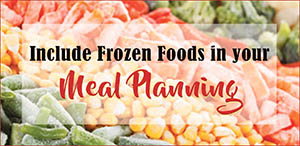Frozen vegetables and fruits can be a convenient way to have quality nutrition options available all seasons of the year.
By Alison Crane
In 1924, Clarence Birdseye invented the quick-freezing method and revolutionized the way we preserved foods. By the 1950s, frozen ready to eat meals had hit the U.S. market and the TV dinner was soon to become a way of life. As home freezers became more widespread and economical, our frozen food options expanded to pizzas and French fries.
Naturally, this innovative and economical way of providing sustenance would catch the eye of our national leaders, causing President Ronald Reagan in 1984 to declare March 6, 1984, as National Frozen Food Day to be observed with “appropriate ceremonies and activities.”
Since you have probably been neglecting your patriotic duty of celebrating this auspicious day, you might feel compelled to eat frozen food for every meal on March 6th. Before you run to the freezer section of your local market, consider this information from Tufts University to help you make wise frozen food choices.
- Frozen produce is at least as nutritious as fresh. After a few days of being stored in a refrigerator, fresh fruits and vegetables have less of certain nutrients than frozen, especially vitamins A and C and folate. Freezing slows down the enzymatic reactions, increases the time food takes to degrade, and maintains freshness. Frozen vegetables and fruits can be a convenient way to have quality nutrition options available all seasons of the year.
- Invest some time to read and compare food labels when purchasing a new frozen food. Even frozen foods that say they are organic or authentic can be high in calories, sodium, or fat. The “Nutrition Facts” labels can help you pick the best new options to try.
- Purchase only the actual fruit or vegetable instead of items with sauces or seasonings. This allows you to control the amount of sodium or fat added to your meal or snack, since many ready-to-eat foods are higher than recommended in these nutrients.
- Convenience must be weighed against nutritional negatives. Read the ingredients list and chose frozen meals or items made with whole foods and not processed foods or containing added chemicals for preservation or flavor enhancement. Look for frozen meal options that include whole grains, quinoa, sweet potatoes, or kale.
- Some frozen meals may have two “servings” in one package but may look like a single meal portion. If you eat the whole package you could be consuming half or more of the recommended amounts of sodium, fat, and calories for a whole day in one meal.
- Frozen foods can be more economical than purchasing fresh or canned produce. Being able to only use what you need of a package of frozen green beans can prevent waste. Having frozen fruits or vegetables can provide high-quality produce all year long at a cost-effective price plus have it ready to use when you are ready to prepare a meal.
If you would like to learn ways to include frozen foods in your meal planning or would like to know how to safely freeze your own TV dinners, contact the Garland County Extension Service at 501-623-6841, or visit www.uaex.uada.edu.
Alison Crane is a Family and Consumer Sciences Agent with the GCES. The UofA System Division of Agriculture offers all its Extension and Research programs to all eligible persons without regard to race, color, sex, gender identity, sexual orientation, national origin, religion, age, disability, marital or veteran status, genetic information, or any other legally protected status, and is an Affirmative Action/Equal Opportunity Employer.









